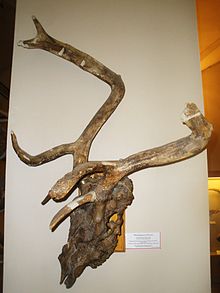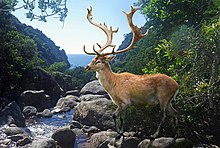| Praemegaceros Temporal range: Early Pleistocene to Holocene | |
|---|---|

| |
| Skull of P. obscurus | |

| |
| Skeleton of P. verticornis | |
| Scientific classification | |
| Domain: | Eukaryota |
| Kingdom: | Animalia |
| Phylum: | Chordata |
| Class: | Mammalia |
| Order: | Artiodactyla |
| Family: | Cervidae |
| Subfamily: | Cervinae |
| Genus: | †Praemegaceros Portis, 1920 |
| Species | |
| |
| Synonyms | |
| |
Praemegaceros is an extinct genus of deer, known from the Pleistocene and Holocene of Western Eurasia. Praemegaceros is considered to be a genus of "giant deer", with many species having an estimated body mass of around 400 kilograms (880 lb), considerably larger than most living deer.
The genus contains the subgenera Praemegaceros, Orthogonoceros and Nesoleipoceros. It has sometimes been synonymised with Megaloceros and Megaceroides, but is regarded as a distinct genus by most studies. Some authors have considered the genus closely related to Megaloceros, but this has been disputed by others.
The earliest species like P. obscurus and P. verticornis appeared in Europe between 2 and 1.5 million years ago. The genus was widely distributed across Europe, West and Central Asia during the Early-Middle Pleistocene, with fossils having been discovered in France, Georgia, Germany, England, Greece, Israel, Italy, Romania, Russia Spain, Syria, and Tajikistan. The genus was extinct in mainland Europe and Asia by end of the Middle Pleistocene. An insular species, P. cazioti survived into the Late Pleistocene and Holocene in isolation on the Sardinia-Corsica archipelago until around 5500 BCE.
Taxonomy
Praemegaceros was first described as a subgenus of Cervus by Portis in 1920, to include Cervus (Praemegaceros) dawkinsi. Kalkhe in 1956 named Orthogonoceros with the type species of Orthogonoceros (previously Cervus) verticornis. Kalkhe in 1965 recognised that these genera were synonyms, with Praemegaceros having priority. Radulesco & Samson in 1967 designated P. dawkinsi as the type species of the genus, while also naming the new genera Allocaenelaphus, Psecupsoceros, and Nesoleipoceros which are now recognised as synonyms of the genus. Some authors have used the genus "Megaceroides" to include the species usually placed in Praemegaceros, but the type species of Megaceroides, the North African Megaceroides algericus is morphologically distinct from Praemegaceros. Praemegaceros is widely agreed to be belong to the subfamily Cervinae. Praemegaceros is considered a genus of "giant deer", and has often been placed in the tribe Megacerini, alongside genera like Megaloceros and Sinomegaceros, though other authors have disputed the close relationship between Praemegaceros and Megaloceros, alternatively suggesting that the two genera obtained their large size independently, and instead propose a close relationship of Praemegaceros with the genus Eucladoceros.
Classification according to Croitor, 2018.
Subgenus Orthogonoceros
Praemegaceros pliotarandoides
Known from the late Early Pleistocene and Middle Pleistocene of Italy, North Greece, Moldova, South Ukraine and the Azov Sea Region. It was named by De Alessandri in 1903 for remains found in North Italy. Psekupsoceros orientalis is a junior synonym of the taxon. Estimated body mass of around 400 kilograms (880 lb).
Praemegaceros verticornis

Named by William Boyd Dawkins in 1872 on the basis of a partial antler from the Cromer Forest Bed. Croitor suggests that Cervus belgrandi is a junior synonym. Known from late Early Pleistocene to Middle Pleistocene localities in England, Spain, France, Germany and Italy. Estimated body mass of around 380 kilograms (840 lb).
Isotopic analysis of
Subgenus Nesoleipoceros
Praemegaceros solilhacus

The species was named by Robert in 1930 for remains from Soleilhac, an early Middle Pleistocene site located in the Massif Central, France. The neotype specimen consists of a partial left frontal with an attached partial antler. The morphology of the preserved antler strongly resembles that of P. cazioti, which suggests a close relationship. Other known sites are from the early Middle Pleistocene of France, Germany, Italy, South Russia and Moldova. This taxon is suggested to be the largest species of Praemegaceros, with an estimated mass of 420 kilograms (930 lb). The taxon appears to have been extinct by the late Middle Pleistocene.
Praemegaceros sardous–Praemegaceros cazioti


Endemic to the Sardinia-Corsica archipelago from the late Middle Pleistocene to the Early Holocene, the ancestor of P. cazioti appears to have dispersed to the islands during the Middle Pleistocene, with the earliest well dated records of Praemegaceros at Su Fossu de Cannas in Sardinia being over 450,000 years in age. Other early remains of the genus in Sardinia are referred to the species P. sardus/sardous. The oldest remains assigned to P. cazioti date to approximately 300,000 years ago. P. cazioti is smaller than P. sardus, being slightly larger than a fallow deer, with an estimated body mass of around 70–90 kilograms (150–200 lb), exhibiting an over 75% size reduction from its presumed mainland ancestor Praemegaceros solilhacus, an example of insular dwarfism. The cranial morphology appears to be unaffected by the insular dwarfism. Two chronologically separated subspecies are known, which are suggested to be chronospecies. P. cazioti cazioti dates to the late Middle Pleistocene and Late Pleistocene and is characterised by smaller brachyodont teeth and P. cazioti algarensis from the end of the Late Pleistocene is larger than P. cazioti cazioti and is characterised by large mesodont upper cheek teeth, and a long premolar series, which are suggested to be adaptions for a grazing diet. The youngest date for P. cazioti is around 5500 BCE, making it the latest surviving Praemegaceros species.
Subgenus Praemegaceros
Praemegaceros obscurus
Known from the late Villafranchian of Europe (including Central Italy, Central Romania and Moldova) and the Near East, extending from the Cromer Forest Bed in England to Ubeidiya, Israel, Dmanisi, Georgia and the Azov region, Russia. Croitor suggests an origin in South Asia for this species, descended from taxa possibly referrable to Panolia sp. from the Siwaliks. Estimated body mass of around 400 kilograms (880 lb).
Praemegaceros dawkinsi
Named in 1882 from remains from the Middle Pleistocene Cromer Forest Bed in Norfolk by Edwin Tulley Newton which were originally described in 1872 as belonging to P. verticornis by William Boyd Dawkins. The body mass is estimated to be around 220 kilograms (490 lb), with a mesodont dentition. Croitor suggests that because the pedicles (base of the antlers) are robust and similar to those of giant deer, that P. dawkinsi represents a dwarfed form. The species is considered to be endemic to Britain, with the antler morphology simplified relative to other Praemegaceros species.
Praemegaceros mosbachensis
Named by Wolfgang Soergel in 1927 for the species found in the lowest level of the Middle Pleistocene Mosbach locality in Germany. It was included in the “verticornis” group of Azzaroli's 1953 classification. It has been suggested to a be synonym of P. verticornis. However, Croitor suggests that these similarities are the result of parallel evolution, and proposes that P. mosbachensis represents an intermediate form between P. obscurus and P. dawkinsi.
Ecology
During the Early-Middle Pleistocene, mainland species of Praemegaceros are suggested to have been preyed upon by the sabertooth cats Megantereon and Homotherium, and the "European jaguar" Panthera gombaszoegensis.
References
- ^ Croitor, Roman (2022-11-06). "Paleobiogeography of Crown Deer". Earth. 3 (4): 1138–1160. Bibcode:2022Earth...3.1138C. doi:10.3390/earth3040066. ISSN 2673-4834.
- Croitor, R. (2006). "Taxonomy and systematics of large-sized deer of the genus Praemegaceros Portis, 1920 (Cervidae, Mammalia)". In Kahlke, R.D.; Maul, L.C.; Mazza, P.P.A. (eds.). Late Neogene and Quaternary Biodiversity and Evolution: Regional Developments and Interregional Correlations. Vol. 1. Stuttgart, Germany: Schweizerbart. pp. 91–116. ISBN 978-3-510-61383-0.
- Rook, Lorenzo; Martínez-Navarro, Bienvenido (June 2010). "Villafranchian: The long story of a Plio-Pleistocene European large mammal biochronologic unit". Quaternary International. 219 (1–2): 134–144. Bibcode:2010QuInt.219..134R. doi:10.1016/j.quaint.2010.01.007.
- "Fossilworks: Praemegaceros". fossilworks.org. Retrieved 17 December 2021.
- Croitor, Roman (2006-11-15). "Taxonomy and systematics of large-sized deer of the genus Praemegaceros PORTIS, 1920 (Cervidae, Mammalia)". Courier Forschungsinstitut Senckenberg. 256 (256). ISSN 0341-4116.
- Croitor, Roman (2014-09-30). "A skull of Praemegaceros pliotarandoides (Cervidae, Mammalia) from the Taman Peninsula (South-West Russia)". 7.
{{cite journal}}: Cite journal requires|journal=(help) - ^ Benzi, Valerio; Abbazzi, Laura; Bartolomei, Paolo; Esposito, Massimo; Fassò, Cecilia; Fonzo, Ornella; Giampieri, Roberto; Murgia, Francesco; Reyss, Jean-Louis (May 2007). "Radiocarbon and U-series dating of the endemic deer Praemegaceros cazioti (Depéret) from "Grotta Juntu", Sardinia". Journal of Archaeological Science. 34 (5): 790–794. Bibcode:2007JArSc..34..790B. doi:10.1016/j.jas.2006.09.001.
- ^ Croitor, Roman (2018). Plio-Pleistocene deer of Western Palearctic : taxonomy, systematics, phylogeny. Institute of Zoology of the Academy of Sciences of Moldova. ISBN 978-9975-66-609-1. OCLC 1057238213.
- Van der Made, Jan (2019). "The dwarfed 'giant deer' Megaloceros matritensis n.sp. from the Middle Pleistocene of Madrid - A descendant of M. savini and contemporary to M. giganteus". Quaternary International. 520: 110–139. Bibcode:2019QuInt.520..110V. doi:10.1016/j.quaint.2018.06.006. S2CID 133792579. Retrieved 2019-02-04.
- Croitor, Roman (July–September 2016). "Systematical position and paleoecology of the endemic deer Megaceroides algericus Lydekker, 1890 (Cervidae, Mammalia) from the late Pleistocene-early Holocene of North Africa". Geobios. 49 (4): 265–283. Bibcode:2016Geobi..49..265C. doi:10.1016/j.geobios.2016.05.002.
- Lister, A.M.; Parfitt, S.A.; Owen, F.J.; Collinge, S.E.; Breda, M. (December 2010). "Metric analysis of ungulate mammals in the early Middle Pleistocene of Britain, in relation to taxonomy and biostratigraphy". Quaternary International. 228 (1–2): 157–179. doi:10.1016/j.quaint.2010.05.014.
- van der Made, J.; Tong, H.W. (March 2008). "Phylogeny of the giant deer with palmate brow tines Megaloceros from west and Sinomegaceros from east Eurasia". Quaternary International. 179 (1): 135–162. Bibcode:2008QuInt.179..135V. doi:10.1016/j.quaint.2007.08.017.
- Vislobokova, I. A. (December 2013). "Morphology, taxonomy, and phylogeny of megacerines (Megacerini, Cervidae, Artiodactyla)". Paleontological Journal. 47 (8): 833–950. Bibcode:2013PalJ...47..833V. doi:10.1134/S0031030113080017. ISSN 0031-0301.
- Croitor, Roman (July 2016). "Systematical position and paleoecology of the endemic deer Megaceroides algericus Lydekker, 1890 (Cervidae, Mammalia) from the late Pleistocene-early Holocene of North Africa". Geobios. 49 (4): 265–283. Bibcode:2016Geobi..49..265C. doi:10.1016/j.geobios.2016.05.002.
- Martinez, K.; Garcia, J.; Carbonell, E.; Agusti, J.; Bahain, J.-J.; Blain, H.-A.; Burjachs, F.; Caceres, I.; Duval, M.; Falgueres, C.; Gomez, M. (2010-03-30). "A new Lower Pleistocene archeological site in Europe (Vallparadis, Barcelona, Spain)". Proceedings of the National Academy of Sciences. 107 (13): 5762–5767. Bibcode:2010PNAS..107.5762M. doi:10.1073/pnas.0913856107. ISSN 0027-8424. PMC 2851913. PMID 20231433.
- Guérin, Claude; Dewolf, Yvette; Lautridou, Jean-Pierre (January 2003). "Révision d'un site paléontologique célèbre : Saint-Prest (Chartres, France)". Geobios (in French). 36 (1): 55–82. Bibcode:2003Geobi..36...55G. doi:10.1016/S0016-6995(02)00106-7.
- Pfeiffer, T. (2002-01-01). "The first complete skeleton of Megaloceros verticornis (Dawkins, 1868) Cervidae, Mammalia, from Bilshausen (Lower Saxony, Germany): description and phylogenetic implications". Fossil Record. 5 (1): 289–308. Bibcode:2002FossR...5..289P. doi:10.5194/fr-5-289-2002. ISSN 2193-0074.
- Abbazzi, Laura (June 2004). "Remarks on the validity of the generic namePraemegaceros portis 1920, and an overview onPraemegaceros species in Italy". Rendiconti Lincei. 15 (2): 115–132. doi:10.1007/BF02904712. ISSN 1120-6349. S2CID 82657199.
- Melis, Rita Teresa; Palombo, Maria Rita; Ghaleb, Bassam; Meloni, Serafino (November 2016). "A key site for inferring the timing of dispersal of giant deer in Sardinia, the Su Fossu de Cannas cave, Sadali, Italy". Quaternary Research. 86 (3): 335–347. Bibcode:2016QuRes..86..335M. doi:10.1016/j.yqres.2016.08.005. ISSN 0033-5894. S2CID 132841915.
- R. Croitor, M.-F. Bonifay, E. Bonifay Origin and evolution of the Late Pleistocene island deer Praemegaceros (Nesoleipoceros) cazioti (Depéret) from Corsica and Sardinia Bulletin du Musée d’Anthropologie Préhistorique de Monaco, 46 (2006), pp. 35-68
- Lister, A.M.; Parfitt, S.A.; Owen, F.J.; Collinge, S.E.; Breda, M. (December 2010). "Metric analysis of ungulate mammals in the early Middle Pleistocene of Britain, in relation to taxonomy and biostratigraphy". Quaternary International. 228 (1–2): 157–179. doi:10.1016/j.quaint.2010.05.014.
- Soergel W. 1927. Cervus megaceros mosbachensis n. sp. und die Stammesgeschichte der Riesenhirsche. Abhandlungen der Senckenbergischen Naturforschenden Gesellschaft, 39 (4): 365-407.
- Domingo, Laura; Rodríguez-Gómez, Guillermo; Libano, Iñaki; Gómez-Olivencia, Asier (August 2017). "New insights into the Middle Pleistocene paleoecology and paleoenvironment of the Northern Iberian Peninsula (Punta Lucero Quarry site, Biscay): A combined approach using mammalian stable isotope analysis and trophic resource availability modeling". Quaternary Science Reviews. 169: 243–262. Bibcode:2017QSRv..169..243D. doi:10.1016/j.quascirev.2017.06.008 – via Elsevier Science Direct.
- Palmqvist, P.; Perez-Claros, J. A.; Janis, C. M.; Figueirido, B.; Torregrosa, V.; Grocke, D. R. (2008-11-01). "Biogeochemical and Ecomorphological Inferences On Prey Selection and Resource Partitioning Among Mammalian Carnivores In An Early Pleistocene Community". PALAIOS. 23 (11): 724–737. Bibcode:2008Palai..23..724P. doi:10.2110/palo.2007.p07-073r. ISSN 0883-1351.
| Taxon identifiers | |
|---|---|
| Praemegaceros | |